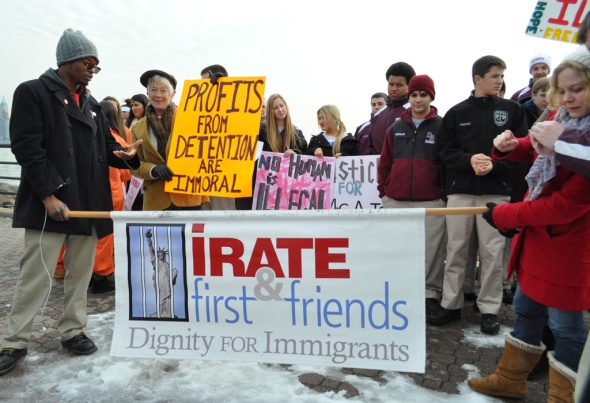One good, but mostly bad and ugly effects of sequestration
1March 6, 2013 by Noel Pangilinan

Immigration rights advocates gather at Liberty State Park in mid-February to protest immigration detention. Photo by NOEL PANGILINAN
THE wide-ranging spending cuts known as sequestration that took effect on March 1 are expected to affect the U.S.’ immigration system and enforcement.
Even before sequestration could take effect, its impact was already felt by immigrant communities. On Feb. 26, the Immigration and Customs Enforcement (ICE) released hundreds of detained immigrants from its more than 250 detention centers all over the country.
Immigration detention
ICE admitted it was a cost-cutting measure. Days before the sequester kicked in, Homeland Security Secretary Janet Napolitano said the automatic budget cuts “would limit the government’s ability to maintain enough detention center beds for at least 34,000 immigrants,” according to an Associated Press report.
Gillian Christensen, spokeswoman for ICE in Washington, D.C., said in a statement that ICE field offices have been directed to review their numbers of detained immigrants to ensure the jail populations stay within budgeted resources and “to make the best use of our limited detention resources in the current fiscal climate.”
The U.S. spends $2 billion annually to maintain detention facilities for immigrants, even those who do not pose any risk. Detention costs from $122 to $164 per person per day; the American Civil Liberties Union said alternative methods cost from 30 cents to $14.
Although critics of immigration detention lauded the release of detainees, they were quick to point out that the releases were a validation of their criticism that detaining immigrants is impractical.
“Since ICE is stating that those have been and will be released in an effort to cut costs pose no threat to the community, it has, in effect admitted that it has been wasting taxpayer dollars by needlessly incarcerating people,” Lorna Henkel, president of the advocacy group IRATE & First Friends, said in a statement.

Students from a New Jersey high school dressed in prison garb show solidarity with immigrant rights advocates in calling for an end to the use of detention to enforce immigration law. Photo by NOEL PANGILINAN
“In the wake of the admission by ICE that the detention of hundreds of immigrants is unnecessary … we renew our call for an end to the arbitrary mass detention of immigrants and urge ICE to stop wasting taxpayer money with its needless incarceration of thousands of workers, parents, care-givers, breadwinners, and family members,” Henkel added.
Visa processing
People wishing to come to the United States either as tourists, students or workers or those intending to immigrate are also severely affected by the sequester. The State Department, which is in charge of processing non-immigrant and immigrant visas, saw its 2013 budget for operations slashed by $850 million.
Secretary of State John Kerry, in his letter to the Senate Appropriations Committee said that the budget cuts would limit the State Department’s capability to “provide secure, error-free travel documents to those eligible to receive them, while denying them to those not eligible.” Kerry also said that reduced funding would also “undermine progress made in ensuring that visa requests are processed in a timely fashion.”
Kerry pointed out that visa processing has a direct impact on the U.S. economy, specifically job creation. “The Department of Commerce estimates that one job is created in America’s travel and tourism industry for every 65 visas issued,” the Secretary of State said in the same letter.
If visas are not processed “in a timely fashion”, the obvious consequence would be a longer waiting time for visas and green cards. As of November last year, there were 4.3 million people on the wait list for family-based visas and 113,058 waiting for employment-based visas. In pre-sequester USA, the waiting time for a green card in some countries such as the Philippines can take as long as 24 years.
Although there are other factors for the long wait for visas, such as oversubscription of visa quotas,the forced budget cuts are expected to limit staffing and resources that will further delay the processing of visas.
USCIS, green cards and citizenship
Like all agencies under the Department of Homeland Security (DHS), the U.S. Citizenship and Immigration Services (USCIS), which processes immigration and citizenship applications, will be hamstrung with deep budget cuts.
For 2013, the USCIS’ allocation will be slashed by $151 million. Although the USCIS generates most of its funds from the fees it collects from processing various applications and services, it cannot escape the fact that it relies on other agencies such as ICE and Customs and Border Protection (CBP) and departments such as State and Labor for processing certain immigration-related benefits.
For example, CBP is the office that processes I-94, the arrival-departure record of foreign citizens entering the U.S in a non-immigrant visa status. The State Department issues non-immigrant visas while the Department of Labor processes the Program Electronic Review Management or PERM labor certifications.
As these agencies resort to furloughs, visa processing in general is expected to slow down and experience significant delays.
Border patrol and entry points
The Customs and Border Patrol (CBP) is among the DHS agencies with the biggest cuts — $754 million. DHS Secretary Napolitano said the CBP “would not be able to maintain current staffing levels of Border Patrol Agents and CBP Officers as mandated by Congress.”
“We are a department that is dependent on personnel. So when we add it up, it is the equivalent in hours of 5,000 Border Patrol agents. It means less overtime and ability to hire port officers,” she said.
As a result, it would take longer now to enter the U.S. legally. Doris Meissner, former commissioner of the U.S. Immigration and Naturalization Service (INS, now USCIS) and now a senior fellow at the Migration Policy Institute (MPI), said the budget slashes mean reduced manpower, which translates into longer lines for airline passengers entering the U.S. and longer wait times for people and goods crossing at land borders with Mexico and Canada.

Critics of immigration detention lauded the release of detainees and reiterated their position that detaining immigrants is a waste of taxpayers’ money. Photo by NOEL PANGILINAN
Immigration courts backlog
The budget cuts will also worsen the backlog of immigration cases. According to latest data, there are 323,725 cases pending before immigration courts.
“The sequestration would cut over $15 million from [the Executive Office for Immigration Review] EOIR’s current budget,” Attorney General Eric Holder said. “EOIR would be forced to cease all hiring of key critical positions for EOIR’s immigration courts, including Immigration Judges, likely increasing pending caseloads to well over 350,000 (an increase of 6 percent over September 2012 levels.” EOIR would also cut contracts for interpreters, legal support, and I.T. staff.”
EOIR holds immigration court hearings that decide whether individuals charged with violating the U.S.’ immigration law are deported or granted permission to stay in the country.
“If you have judges and court clerks who have to take a day’s furlough once a week, then that’s 20 percent [cut in productivity],” Meissner of MPI said.
At the moment, an average immigration court case takes 550 days before a decision is handed down. With reduced manpower and tighter budget, the waiting time has just grown longer.
All these consequences will remain in place until and unless President Obama and the Republicans in Congress can come together and forge a deal to end the sequester.


Way cool! Some very valid points! I appreciate you penning this post and also the rest of the website is extremely good.|